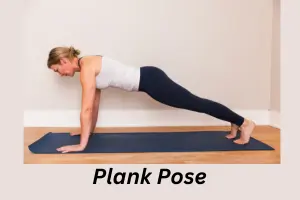Introduction
Plank Pose, known as Phalakasana in Sanskrit, is a fundamental asana in yoga that serves as a cornerstone for building strength, stability, and endurance.
This pose mimics the position of a plank of wood, hence its name, and is renowned for its effectiveness in engaging multiple muscle groups, including the core, arms, shoulders, and legs.
Practicing Plank Pose can help improve overall body alignment and posture while serving as a precursor to more advanced yoga poses.

Beyond its physical benefits, Plank Pose is also excellent for developing mental focus and discipline.
It challenges practitioners to maintain stability and balance, making it a valuable addition to any yoga practice or fitness routine.
Whether you’re a beginner or an experienced yogi, incorporating Plank Pose into your routine can lead to significant improvements in strength and endurance.
Steps to Perform Plank Pose (Phalakasana)
- Start in a Tabletop Position: Begin on your hands and knees in a tabletop position. Ensure that your wrists are aligned directly under your shoulders and your knees are beneath your hips.
- Engage Your Core: As you prepare to move into Plank Pose, engage your abdominal muscles by drawing your belly button in toward your spine. This action helps stabilize your body.
- Step Back: Slowly step your feet back, one foot at a time, until your body forms a straight line from the top of your head to your heels. Your feet should be hip-width apart.
- Align Your Body: Ensure your shoulders are directly above your wrists and your body is in a straight line. Avoid sagging your hips or lifting your buttocks too high.
- Focus on Your Gaze: Keep your gaze slightly ahead of your hands, focusing on a point on the mat. This helps maintain a neutral neck position and enhances stability.
- Breathe Deeply: Take deep, steady breaths as you hold the pose. Aim to hold the Plank for 20 to 30 seconds to start, gradually increasing the duration as you build strength.
- Exit the Pose: To release, gently lower your knees to the mat and transition back to the tabletop position or move into Child’s Pose for a brief rest.
Benefits of Plank Pose (Phalakasana)
- Strengthens Core Muscles: Plank Yoga Pose effectively engages and strengthens the entire core, including the abdominals, obliques, and lower back, which is essential for overall stability.
- Improves Posture: By promoting proper alignment of the spine, shoulders, and pelvis, Plank Pose helps improve posture, reducing the risk of back and neck pain.
- Enhances Upper Body Strength: This pose engages the arms, shoulders, and chest, helping to build upper body strength over time.
- Increases Endurance: Holding Plank Pose for extended periods builds endurance in both the muscles and the mind, fostering resilience and focus.
- Boosts Metabolism: Engaging multiple muscle groups simultaneously during Plank Pose can help elevate the heart rate and boost metabolism.
- Promotes Mental Focus: The concentration required to hold the pose enhances mental clarity and focus, making it an excellent exercise for both body and mind.
- Prepares for Advanced Poses: Plank Yoga Pose serves as a foundational position for many advanced yoga postures, including arm balances and inversions.
Precautions and Contraindications for Plank Pose (Phalakasana)
- Wrist Issues: Individuals with wrist pain or injuries should approach this pose with caution, considering alternative positions such as forearm Plank.
- Back Pain: Those with chronic back issues should consult a healthcare professional before practicing Plank Yoga Pose, ensuring they maintain proper alignment to avoid strain.
- Shoulder Injuries: Practitioners with shoulder injuries should modify the pose or avoid it entirely to prevent aggravating their condition.
- Pregnancy: Pregnant individuals should seek guidance from a qualified instructor before practicing Plank Pose, particularly in later trimesters.
- Fatigue: If you feel fatigued or unable to maintain proper form, it’s advisable to take a break or perform a modified version of the pose.
- Head and Neck Issues: Those with neck or head injuries should maintain a neutral neck position and avoid excessive strain while practicing.
Conclusion
- Plank Yoga pose is a powerful and versatile asana that offers a myriad of benefits for both the body and mind.
- Its ability to strengthen core muscles, improve posture, and enhance mental focus makes it an essential part of any yoga or fitness routine.
- By incorporating Plank Yoga Pose into your practice, you can build a solid foundation for advanced poses while fostering overall strength and endurance.
- As you practice, remember to focus on maintaining proper alignment and breathing deeply.
- Embrace the challenge of holding the pose, allowing it to teach you about resilience and concentration.
- Whether you hold it for a few breaths or several minutes, Plank Yoga Pose will contribute significantly to your yoga journey and overall well-being.
- Feel free to integrate this pose into your daily routine, and enjoy the strength and stability it brings to both your physical practice and your daily life.
